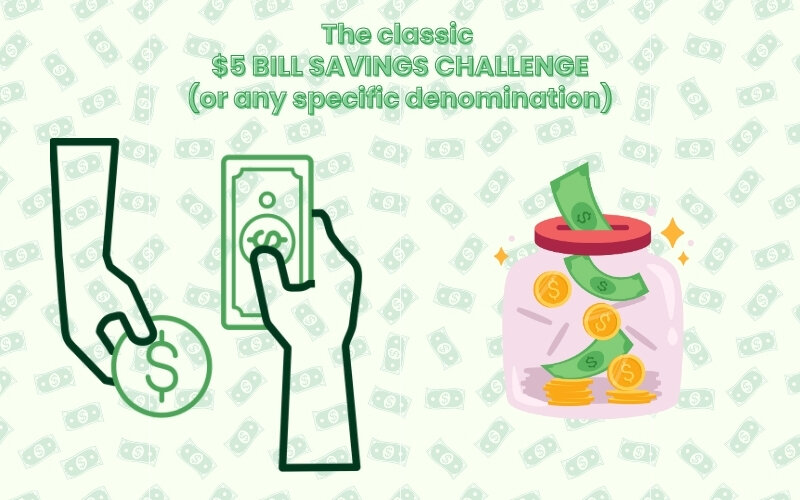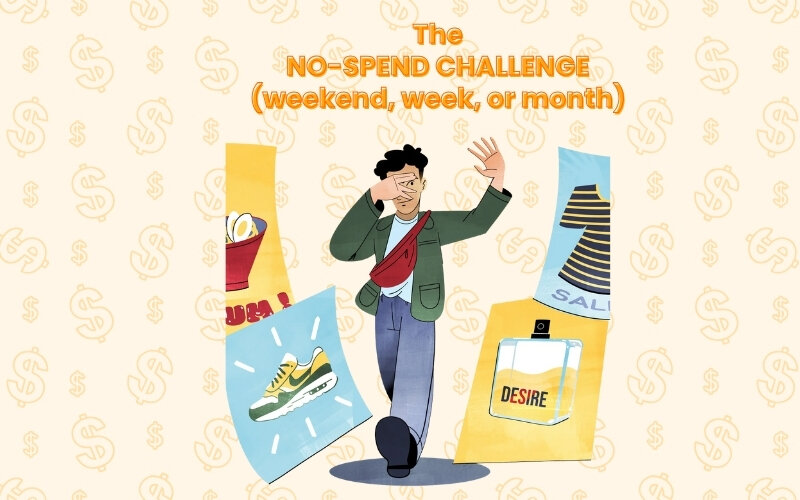Are you searching for engaging and effective save money challenge ideas to kickstart your wealth-building journey? Saving money can often feel daunting, tedious, and easy to abandon midway.
However, saving money challenges offer a fantastic solution, transforming the act of saving into a motivating “game” while helping you build solid financial habits. This article will introduce over 15 diverse save money challenge ideas, ranging from classic methods to innovative approaches, ensuring you’ll find at least one perfect challenge to conquer your savings goals.
Key takeaways:
- Saving challenges turn saving money into an engaging habit, making it easier to build financial discipline gradually.
- Starting simple with beginner-friendly challenges like the 52-week or $5 bill savings helps build momentum without overwhelming effort.
- Setting clear, specific goals and using tools like visual trackers boost motivation and make saving purposeful.
- Regular tracking, accountability, and automation are essential for maintaining consistency and overcoming motivation dips.
- After saving, prioritize strengthening your emergency fund and paying down high-interest debt before pursuing other financial goals.
1. Savings challenge ideas for beginners
If you’re new to saving, starting with simple challenges can make the process less overwhelming and more rewarding. These savings challenge ideas for beginners focus on easy, low-pressure steps to help you build momentum. Over time, they lay the groundwork for more disciplined financial habits without requiring drastic changes.
1.1. The 52-week money challenge: Save $1,378 in a year
This is perhaps one of the most well-known save money challenge ideas, celebrated for its simplicity and gradual build-up.

- How it works: The premise is straightforward. In week one, you save $1 (or an equivalent small amount in your local currency). In week two, you save $2, and you continue to incrementally increase the amount you save by $1 each week. By week 52, you’ll be saving $52 for that week.
- Potential savings: If you follow this structure diligently, you’ll have accumulated a significant $1,378 by the end of the year.
- Variations:
- Reverse 52-week challenge: For those who find it easier to tackle larger amounts when motivation is highest at the beginning, this variation has you save $52 in week one, $51 in week two, and so on, decreasing the amount weekly.
- Fixed amount 52-week challenge: If the incremental increase feels too steep towards the end, or if you prefer consistency, you can opt to save a fixed amount each week (e.g., $10, $20, or $25) for all 52 weeks. The total will depend on your chosen weekly amount.
- Best for: Individuals who appreciate consistency and enjoy the motivational boost of seeing their savings grow systematically over time. It’s an excellent entry-level option among the many save money challenge ideas, as it starts small and builds discipline.
1.2. The $5 bill savings challenge (or any specific denomination)
For those who enjoy simplicity and a touch of serendipity in their savings, this is one of the most effortlessly implementable save money challenge ideas.

- How it works: The rule is wonderfully simple: every time you receive a specific banknote in your change – traditionally a $5 bill, but it could be a $10 bill, a $1 bill, or an equivalent in your local currency (like a £5 note or a 100k VND note) – you must set it aside instead of spending it.
- The surprise element: You’ll likely be astonished at how quickly these “found” notes accumulate. Without actively budgeting for it, you can build a respectable stash by the end of a month or quarter. It feels less like a sacrifice and more like a fun discovery.
- Best for: People who prefer straightforward, low-effort save money challenge ideas that don’t require complex calculations or tracking. It injects a “treasure hunt” feel into daily transactions and can be surprisingly effective for those who frequently handle cash.
1.3. The spare change/ Round-up challenge
This is one of the classic save money challenge ideas that proves even small amounts can make a big difference over time. It’s incredibly accessible to everyone.

- How it works: There are two main approaches:
- Physical spare change: Collect all the loose coins you receive as change from cash purchases. Designate a jar, piggy bank, or container specifically for this purpose.
- Digital round-ups: For card transactions, you can mentally or, more conveniently, through banking apps, round up your purchases to the nearest dollar (or chosen currency unit). For instance, if a coffee costs $3.40, you’d round it up to $4.00 and transfer the $0.60 difference to your savings. Many modern banking apps automate this, making it seamless.
- Implementation: For physical change, simply empty your pockets or wallet into the designated container daily. For digital round-ups, either manually track and transfer the amounts weekly/monthly or utilize an automated app feature.
- Best for: Absolutely everyone, but it’s particularly effective for those who frequently use cash or those who want to save small, almost unnoticeable amounts consistently. This is one of the gentlest save money challenge ideas, making it easy to start and maintain.
1.4. The Specific Goal savings challenge (e.g., vacation fund, emergency fund)
This is one of the most motivating save money challenge ideas because it ties your saving efforts directly to a tangible and desired outcome.
- How it works:
- First, you clearly define a specific financial goal you want to achieve. This could be anything from saving for a down payment on a car, funding a dream vacation, building an emergency fund of a certain amount, or purchasing a particular high-value item like new tech.
- Next, you break down this larger goal into smaller, more manageable weekly or monthly savings targets. For example, if you want to save $1,200 for a vacation in a year, your monthly target would be $100, or roughly $25 per week.
- Supporting tools:
- Creating a “visual tracker” can be incredibly effective. This could be a chart where you color in segments as you reach milestones, a picture of your goal that you gradually uncover, or even a dedicated savings thermometer. Seeing your progress visually reinforces your commitment.
- Best for: Individuals who are highly motivated by clear, defined objectives and find satisfaction in working towards a specific, rewarding outcome. This approach makes the abstract concept of “saving” concrete and purposeful, making it one of the most effective save money challenge ideas for goal-oriented people.

This is an excellent opportunity to gently re-emphasize the critical importance of establishing or bolstering an emergency fund as a primary financial goal. Many successful money-saving challenge ideas are geared towards this foundational aspect of financial security.
2. Weekly money-saving challenges
Weekly money-saving challenges offer a manageable way to build your savings gradually. By setting short-term goals each week, you stay motivated and consistent without feeling overwhelmed. These challenges are perfect for creating steady progress and making saving a natural part of your routine.
2.1. The no-spend challenge (weekend, week, or month)
This particular choice among save money challenge ideas is more intensive but can deliver rapid results and powerful insights into your spending habits.
- How it works: You commit to not spending any money on non-essential items for a predetermined period – this could be a no-spend weekend, a full week, or even an entire month for the truly dedicated. The core idea is to curb all discretionary spending.
- Differentiating “essentials” from “non-essentials”: This is crucial for success.
- Essentials typically include: Rent or mortgage payments, utility bills (electricity, water, gas), basic groceries for home cooking, essential medication, and minimal transportation costs for work or critical errands.
- Non-essentials cover: Dining out, takeaway coffees, new clothes or accessories, entertainment (movies, concerts), hobbies that incur costs, impulse buys, and any other spending that isn’t strictly necessary for survival or contractual obligations.
- Tips for success:
- Plan free activities in advance: Visit the library, go for a hike, explore local parks, have a board game night, or work on a creative project using materials you already own.
- Meal prep: Ensure you have enough food at home to avoid the temptation of ordering in.
- Communicate your challenge: Let friends and family know so they can support you and understand if you decline certain invitations that involve spending.
- Best for: Individuals looking to “reset” their spending habits, quickly identify and eliminate wasteful expenditures, or make significant financial cutbacks in a short timeframe. It’s one of the more demanding save money challenge ideas, but it offers a clear view of spending triggers.

I committed to a no-spend week, which was tougher than I anticipated. The first few days were filled with cravings for my usual coffee runs and takeout dinners. However, I found joy in rediscovering free activities, like hiking and reading at home. By the end of the week, I felt accomplished and saved over $100, which motivated me to continue being mindful of my spending habits.
2.2. The pantry/ Eat-at-Home challenge
This practical choice among save money challenge ideas targets one of the largest variable expenses for many households: food. It encourages resourcefulness and mindful consumption.
- How it works: The primary goal is to prioritize using up all existing food items in your pantry, refrigerator, and freezer before purchasing new groceries. This means getting creative with ingredients you already have on hand. Alongside this, you significantly limit or entirely eliminate eating out, ordering takeaways, and buying pre-made meals for a set period (e.g., a week or a month).
- Benefits:
- Significant cost savings: Dining out and takeaways are considerably more expensive than home-cooked meals. This challenge can free up a substantial amount of your food budget.
- Reduced food waste: It forces you to use items before they expire, minimizing the amount of food thrown away.
- Improved cooking skills: You’ll likely experiment with new recipes and learn to make the most of your ingredients.
- Best for: Individuals or families looking to make a noticeable dent in their daily living expenses, those who are conscious about reducing food waste, and anyone who enjoys (or wants to improve at) home cooking. This is one of the save money challenge ideas that offers both financial and practical lifestyle benefits.

This challenge was both fun and challenging. I had to get creative with the random ingredients in my pantry. Some meals turned out surprisingly delicious, while others were less than stellar! The thrill of using what I had, rather than buying new groceries, helped reduce my food waste. I saved about $80 in a month and learned some valuable cooking skills along the way.
2.3. The “Cancel a Subscription” challenge
In today’s subscription-heavy world, this is one of the most relevant and potentially impactful save money challenge ideas for uncovering hidden drains on your finances.

- How it works: Take a thorough inventory of all your recurring monthly or annual subscriptions. This includes streaming services (music, TV, movies), gym memberships, software licenses, app subscriptions, magazine or newspaper subscriptions, subscription boxes, and any other service you pay for regularly. The challenge is to critically evaluate each one and cancel those you rarely use, don’t truly need, or can live without. The money saved from these cancellations is then redirected into your savings.
- Tips for execution:
- List them all: Go through your bank and credit card statements to identify every recurring payment. Note down the service and its cost.
- Assess usage honestly: For each subscription, ask yourself how often you genuinely use it and whether it provides value proportionate to its cost. Be ruthless!
- Best for: Almost everyone in the modern age, but particularly those who suspect they might be oversubscribed or have signed up for services they’ve forgotten about or no longer use. This is one of the save money challenge ideas that can lead to easy, ongoing monthly savings with minimal lifestyle disruption once set up.
3. Creative & fun money challenges
Creative and fun money challenges turn saving into something you’ll actually look forward to. By adding a playful twist to your financial goals, these ideas keep you engaged and motivated. They’re perfect for anyone who wants to break the routine and make budgeting feel less like a chore.
3.1. The Bad Habit Jar challenge
This is one of the more creative save money challenge ideas that cleverly links financial goals with personal development.

- How it works: Identify a specific “bad habit” you want to break or reduce (e.g., swearing, smoking, being late, mindlessly scrolling social media, buying daily takeaway coffee instead of making it at home). Every time you catch yourself engaging in this habit, you “fine” yourself by putting a pre-agreed amount of money into a designated jar or account.
- “Good Habit Jar” variation: To make it more positive, you can also implement a “Good Habit Jar.” Reward yourself by putting a small sum into this jar each time you successfully practice a desired good habit (e.g., exercising, reading a book, meditating).
- Best for: Individuals looking to combine their savings objectives with self-improvement goals. It turns the process of breaking negative patterns or reinforcing positive ones into a financially rewarding endeavor. This is one of the save money challenge ideas that offers a dual benefit.
3.2. The weather savings challenge
If you’re looking for save money challenge ideas that are a bit quirky and less structured, this one adds an element of fun and unpredictability.
- How it works: Your savings amount for the day (or week) is determined by the weather. There are several ways to approach this:
- Save an amount based on the day’s highest temperature (e.g., $1 for every 5 degrees Celsius, or $0.50 for every degree Fahrenheit).
- Save a fixed amount if it rains, and a different (perhaps smaller) amount if it’s sunny.
- Assign different saving amounts to different weather conditions (cloudy, windy, snowy).
- Random and fun: The unpredictability makes it feel less like a chore and more like a game of chance. It can be a lighthearted way to add to your savings without strict adherence to a rigid plan.
- Best for: People who enjoy novelty, prefer a less structured approach to saving, and are looking for save money challenge ideas that inject an element of surprise and lightheartedness into their financial routine. It might not yield massive sums, but every little bit helps!

This quirky challenge added a playful twist to saving money. I saved based on the highest temperature each day, which made me excited to check the weather. Some days I saved a lot, while others were minimal, depending on the weather. It kept me engaged and made the process feel like a game.
3.3. The “Digital Detox” savings challenge
In an era of constant online connectivity and targeted advertising, this is one of the save money challenge ideas that addresses modern spending triggers.
- How it works: The core idea is to consciously reduce non-essential online time, particularly time spent browsing e-commerce websites, social media platforms filled with influencer marketing, or any online space that tempts you into making impulsive purchases when you have no genuine prior need. The money you avoid spending on these unbanned, impulse buys is then notionally (or actually, if you track it) considered saved.
- Focus on behavior change: While it can be more difficult to quantify the exact “savings” compared to other challenges, its strength lies in fostering a change in consumer behavior – moving away from reactive, impulse-driven spending towards more mindful purchasing decisions. This is a key long-term benefit offered by these types of savings challenge ideas.
- Tips for success:
- Unsubscribe from promotional emails from retailers you don’t need to hear from regularly.
- Unfollow social media accounts or pages that primarily exist to sell products and frequently trigger your urge to buy.
- Set time limits for browsing shopping apps or websites.
- Best for: Individuals who recognize they are prone to frequent, uncontrolled online shopping or are easily swayed by digital marketing. This challenge helps curb that habit, reinforcing more deliberate spending choices.

Reducing my online shopping time was a real eye-opener. I found myself mindlessly scrolling through e-commerce sites, but I replaced that time with hobbies like painting and gardening. I realized how much I could save by avoiding impulsive buys, ultimately saving around $150 over a month.
Make your own challenges
Overall, each challenge taught me valuable lessons about my spending habits and helped me save money while enjoying the process. Beyond these structured save money challenge ideas, remember that you can always get creative and tailor a challenge to your unique lifestyle and spending patterns.
For instance, you might invent a “DIY Lunch Challenge,” committing to bringing homemade lunch to work or school every day for a month. Or, consider a “Transportation Challenge,” where you explore cheaper commuting options like cycling, walking, or carpooling. Even a “Voucher/Coupon Master Challenge,” focused on maximizing discounts on necessary purchases, can free up significant cash.
The most effective money-saving challenge ideas are often those that you personalize, making them both sustainable and enjoyable. The key is to find an approach that doesn’t feel overly restrictive but still pushes you towards your financial goals.
See more useful articles:
4. 6 Tips for successfully completing your savings challenge ideas
Choosing a savings challenge is only the beginning. To follow through and achieve your goal, you need a realistic approach that aligns with your habits, income, and motivation style. The following strategies will help you stay focused, track your progress, and adapt along the way.
4.1. Choose a challenge that fits your lifestyle
Savings challenges aren’t one-size-fits-all. If you’re a meticulous planner, you may enjoy structured goals like a weekly savings tracker. If you’re more spontaneous, a flexible no-spend weekend challenge may be more effective. The key is to match the format with your routines and money mindset. Starting with a simple plan increases your chance of success.
4.2. Set SMART financial goals
Clear, measurable goals give you something to work toward and a way to track progress. The SMART framework ensures your objectives are structured for long-term results.
| SMART Element | Example |
|---|---|
| Specific | Save $1,000 for an emergency fund |
| Measurable | Track progress monthly in a spreadsheet or app |
| Achievable | Save $100/month by cutting dining-out expenses |
| Relevant | Aligns with broader goal of financial security |
| Time-bound | Complete the challenge in 10 months |
Setting up your savings challenge ideas with this clarity helps build consistency and momentum over time.
4.3. Track your progress consistently
Tracking keeps you accountable. Whether through a digital budgeting app, a spreadsheet, or even a printed savings tracker, regular updates allow you to see growth, however gradual, which reinforces your commitment.
4.4. Use accountability and automation to your advantage
An accountability partner, even just one friend or colleague, can offer the encouragement you need when motivation dips. Automating your transfers on payday also removes the decision-making friction and makes saving a default action.
4.5. Visualize your outcome and reward milestones
Keeping your goal visible helps maintain focus. A printed photo of your travel destination, new laptop, or debt-free vision board can be a powerful motivator. Celebrate milestones with small, non-financial rewards, like a relaxing evening or time for a favorite hobby, to maintain morale without derailing your progress.
4.6. Stay flexible and review regularly
If your current plan no longer fits your life or feels overwhelming, it’s okay to adjust. Flexibility is often the reason some savings challenge ideas succeed where others fail. Reassess, realign, and keep moving forward.
5. What to do with the money you’ve saved?
Once you’ve completed your savings challenge, start by reinforcing your financial foundation. Use the funds to build or top up your emergency fund, ideally covering 3–6 months of expenses. If high-interest debt is holding you back, consider paying it down to reduce future financial strain.

6. Conclusion
Exploring save money challenge ideas is a simple yet powerful way to improve your financial habits. From the 52-week challenge to no-spend weekends, these strategies turn saving into a fun, achievable goal while helping you gain better control over your spending.
Start building healthy financial habits today with practical tips from the Budgeting Strategies section of H2T Funding. Which save money challenge will you try first? Let us know in the comments!





